.gif)
Geode (processor)
Encyclopedia
.jpg)
.jpg)
- For other uses of Geode, see Geode (disambiguation)Geode (disambiguation)Geode may refer to:* Bone cyst, also called geode* Geode, geological rock formation* Geode , European gas and electricity distributors* Geode , microprocessor series* Mozilla Geode, geo-tagging project...
Geode is a series of x86-compatible system-on-a-chip
System-on-a-chip
A system on a chip or system on chip is an integrated circuit that integrates all components of a computer or other electronic system into a single chip. It may contain digital, analog, mixed-signal, and often radio-frequency functions—all on a single chip substrate...
microprocessor
Microprocessor
A microprocessor incorporates the functions of a computer's central processing unit on a single integrated circuit, or at most a few integrated circuits. It is a multipurpose, programmable device that accepts digital data as input, processes it according to instructions stored in its memory, and...
s and I/O companions produced by AMD, targeted at the embedded computing
Embedded system
An embedded system is a computer system designed for specific control functions within a larger system. often with real-time computing constraints. It is embedded as part of a complete device often including hardware and mechanical parts. By contrast, a general-purpose computer, such as a personal...
market.
The series was originally launched by National Semiconductor
National Semiconductor
National Semiconductor was an American semiconductor manufacturer, that specialized in analog devices and subsystems,formerly headquartered in Santa Clara, California, USA. The products of National Semiconductor included power management circuits, display drivers, audio and operational amplifiers,...
as the Geode family in 1999. The original Geode processor core itself is derived from the Cyrix
Cyrix
Cyrix Corporation was a microprocessor developer that was founded in 1988 in Richardson, Texas as a specialist supplier of high-performance math coprocessors for 286 and 386 microprocessors. The company was founded by former Texas Instruments staff members and had a long but troubled relationship...
MediaGX
MediaGX
The MediaGX CPU was an x86 processor manufactured and designed by Cyrix and later after merger manufactured by National Semiconductor, and was introduced in 1997. The core is based on the integration of the Cyrix Cx5x86 CPU core with hardware to process video and audio output...
platform, which was acquired in National's merger with Cyrix in 1997. AMD bought the Geode business from National in August 2003 to augment its existing line of embedded x86 processor products. AMD expanded the Geode series to two classes of processor: the MediaGX-derived Geode GX and LX, and the modern Athlon
Athlon
Athlon is the brand name applied to a series of x86-compatible microprocessors designed and manufactured by Advanced Micro Devices . The original Athlon was the first seventh-generation x86 processor and, in a first, retained the initial performance lead it had over Intel's competing processors...
-derived Geode NX.
Geode processors are optimized for low power consumption and low cost while still remaining compatible with software written for the x86 platform. The MediaGX-derived processors lack modern features such as SSE
Streaming SIMD Extensions
In computing, Streaming SIMD Extensions is a SIMD instruction set extension to the x86 architecture, designed by Intel and introduced in 1999 in their Pentium III series processors as a reply to AMD's 3DNow! . SSE contains 70 new instructions, most of which work on single precision floating point...
and a large on-die L1 cache but these are offered on the more recent Athlon-derived Geode NX. Geode processors tightly integrate some of the functions normally provided by a separate chipset
Chipset
A chipset, PC chipset, or chip set refers to a group of integrated circuits, or chips, that are designed to work together. They are usually marketed as a single product.- Computers :...
, such as the northbridge
Northbridge (computing)
The northbridge has historically been one of the two chips in the core logic chipset on a PC motherboard, the other being the southbridge. Increasingly these functions have migrated to the CPU chip itself, beginning with memory and graphics controllers. For Intel Sandy Bridge and AMD Fusion...
. Whilst the processor family is best suited for thin client
Thin client
A thin client is a computer or a computer program which depends heavily on some other computer to fulfill its traditional computational roles. This stands in contrast to the traditional fat client, a computer designed to take on these roles by itself...
, set top box and embedded computing
Embedded system
An embedded system is a computer system designed for specific control functions within a larger system. often with real-time computing constraints. It is embedded as part of a complete device often including hardware and mechanical parts. By contrast, a general-purpose computer, such as a personal...
applications, it can be found in unusual applications such as the Nao robot
Nao (robot)
Nao is an autonomous, programmable, medium-sized humanoid robot, developed by Aldebaran Robotics, a French startup company headquartered in Paris. Project Nao was launched in 2004. On August 15, 2007, Nao replaced Sony's robot dog Aibo as the robot used in the Robot Soccer World Cup Standard...
and the Win Enterprise IP-PBX
The One Laptop per Child project originally used the GX series Geode processor in the OLPC XO, but it has since moved to the Geode LX. The Linutop
Linutop
The Linutop is a small, light, environment friendly nettop computer with a metal case, no moving parts, and running the Linutop OS , a customized version of Linux based on the Xubuntu then Ubuntu/GNOME distribution....
(rebranded Artec ThinCan
ThinCan
ThinCan is the name for a thin client manufactured by Estonian electronic design start-up Artec Group. The ThinCan remained relatively unknown outside Estonia until 2006, when a recent ThinCan iteration was selected as the hardware base for the Linutop, a network appliance that greatly stimulated...
DBE61C or rebranded FIC ION603A) is also based on the Geode LX. 3Com Audrey
3Com Audrey
The 3Com Ergo Audrey is a discontinued internet appliance from 3Com. It was released to the public on October 17, 2000 for USD499 as the first device in the company's "Ergo" initiative to hit the market...
was powered by a 200 MHz Geode GX1.
The SCxxxx range of Geode devices are a single-chip version, comparable to the SiS
Silicon Integrated Systems
Silicon Integrated Systems is a company that manufactures, among other things, motherboard chipsets. The company was founded in 1987 in Hsinchu Science Park, Taiwan.-Business:...
552, VIA CoreFusion
VIA CoreFusion
VIA CoreFusion is a single package integration of low-powered VIA x86 processors and Northbridges with integrated graphics.The CoreFusion platform is available in three configurations, named Mark, Luke and John.- External links :*...
or Intel's Tolapai
Tolapai
Tolapai is the code name of Intel's system-on-a-chip embedded processor which combines an x86 processor core, DDR2 memory controllers and I/O controllers, and a QuickAssist Integrated Accelerator unit for security functions....
, which integrate the CPU, memory controller, graphics and I/O devices into one package. Single processor boards based on these processors are manufactured by Artec Group
ThinCan
ThinCan is the name for a thin client manufactured by Estonian electronic design start-up Artec Group. The ThinCan remained relatively unknown outside Estonia until 2006, when a recent ThinCan iteration was selected as the hardware base for the Linutop, a network appliance that greatly stimulated...
, PC Engines (WRAP
Wireless Router Application Platform
The Wireless Router Application Platform is a format of single board computer defined by Swiss company PC Engines. This is specially designed for wireless router, firewall, load balancer, VPN or other network appliances.-Basic specs:...
), Soekris, and Win Enterprises.
These processors are named after geode
Geode
Geodes are geological secondary sedimentary structures which occur in sedimentary and certain volcanic rocks. Geodes are essentially spherical masses of mineral matter that were deposited sygenetically within the rock formations they are found in. Geodes have a Chalcedony shell containing...
s.
Geode GXm
Cyrix MediaGXMediaGX
The MediaGX CPU was an x86 processor manufactured and designed by Cyrix and later after merger manufactured by National Semiconductor, and was introduced in 1997. The core is based on the integration of the Cyrix Cx5x86 CPU core with hardware to process video and audio output...
m clone. Returns "CyrixInstead" on CPUID
CPUID
The CPUID opcode is a processor supplementary instruction for the x86 architecture. It was introduced by Intel in 1993 when it introduced the Pentium and SL-Enhanced 486 processors....
.
- MediaGX-derived core
- 0.35 µm four layer metal CMOS
- MMX instructions
- 3.3 V I/O, 2.9 V core
- 16 Kb write-back unified L1 cache
- PCI controller
- 64-bit SDRAM memory
- CS5530 companion chip (implements sound and video functions)
- VSA architecture
- 1280x1024x8 or 1024x768x16 display
Geode GXLV
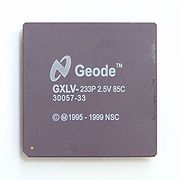
- MediaGX-derived core
- 0.25 µm four layer metal CMOS
- 3.3 V I/O
- 2.2 V, 2.5 V, 2.9 V core
- 16 kb write-back unified L1 cache
- Fully static design
- 1.0 W @2.2 V/166 MHz, 2.5 W @2.9 V/266 MHz
Geode GX1
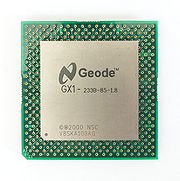
- MediaGX-derived core
- 0.18 µm CMOS
- 200 - 333 MHz
- 1.6 - 2.2 V core
- 16 kB (16 KiBKibibyteThe kibibyte is a multiple of the unit byte for quantities of digital information. The binary prefix kibi means 1024; therefore, 1 kibibyte is . The unit symbol for the kibibyte is KiB. The unit was established by the International Electrotechnical Commission in 1999 and has been accepted for use...
) L1 cache - 0.8 W - 1.2 W typical
- SDRAMSDRAMSynchronous dynamic random access memory is dynamic random access memory that is synchronized with the system bus. Classic DRAM has an asynchronous interface, which means that it responds as quickly as possible to changes in control inputs...
memory 111 MHz - CS5530A companion chip
- 85 Hz VGA refresh rate
National Semiconductor/AMD SC1100 is based on the Cyrix GX1 core and the CS5530 support chip.
Geode GX2
Announced by National Semiconductor Corporation October, 2001 at Microprocessor Forum. First demonstration at COMPUTEX Taiwan, June, 2002.- 0.15 µm process technology
- MMX and 3DNow!3DNow!3DNow! is an extension to the x86 instruction set developed by Advanced Micro Devices . It adds single instruction multiple data instructions to the base x86 instruction set, enabling it to perform simple vector processing, which improves the performance of many graphic-intensive applications...
instructions - 16 kB Instruction and 16 kB Data caches
- GeodeLink architecture, 6 GBGigabyteThe gigabyte is a multiple of the unit byte for digital information storage. The prefix giga means 109 in the International System of Units , therefore 1 gigabyte is...
/s on-chip bandwidth, up to 2 GB/s memory bandwidth - Integrated 64-bit PC133 SDRAM and DDR266DDR SDRAMDouble data rate synchronous dynamic random access memory is a class of memory integrated circuits used in computers. DDR SDRAM has been superseded by DDR2 SDRAM and DDR3 SDRAM, neither of which are either forward or backward compatible with DDR SDRAM, meaning that DDR2 or DDR3 memory modules...
controller - Clockrate: 266, 333 and 400 MHz
- 3 PCI masters supported
- 1600x1200x24 bit display with video scaling
- CRT DACs and an UMA DSTN/TFT controller.
- Geode CS5535 companion chip
AMD Geode
In 2002, AMD introduced the Geode GX series, which was a re-branding of the National Semiconductor GX2. This was quickly followed by the Geode LX, running up to 667 MHz. LX brought many improvements, such as higher speed DDR, a re-designed instruction pipe, and a more powerful display controller. The upgrade from the CS5535 I/O Companion to the CS5536 brought higher speed USB.Geode GX and LX processors are typically found in devices such as thin clients and industrial control systems. However, they have come under competitive pressure from VIA
VIA Technologies
VIA Technologies is a Taiwanese manufacturer of integrated circuits, mainly motherboard chipsets, CPUs, and memory, and is part of the Formosa Plastics Group. It is the world's largest independent manufacturer of motherboard chipsets...
on the x86 side, and ARM
ARM architecture
ARM is a 32-bit reduced instruction set computer instruction set architecture developed by ARM Holdings. It was named the Advanced RISC Machine, and before that, the Acorn RISC Machine. The ARM architecture is the most widely used 32-bit ISA in numbers produced...
and XScale
XScale
The XScale, a microprocessor core, is Intel's and Marvell's implementation of the ARMv5 architecture, and consists of several distinct families: IXP, IXC, IOP, PXA and CE . Intel sold the PXA family to Marvell Technology Group in June 2006....
taking much of the low-end business.
Because of the relative performance, albeit higher PPW
Performance per watt
In computing, performance per watt is a measure of the energy efficiency of a particular computer architecture or computer hardware. Literally, it measures the rate of computation that can be delivered by a computer for every watt of power consumed....
, of the GX and LX core design, AMD introduced the Geode NX, which is an embedded version of the highly-successful Athlon
Athlon
Athlon is the brand name applied to a series of x86-compatible microprocessors designed and manufactured by Advanced Micro Devices . The original Athlon was the first seventh-generation x86 processor and, in a first, retained the initial performance lead it had over Intel's competing processors...
processor, K7. Geode NX uses the Thoroughbred core and is quite similar to the Athlon XP-M that use this core. The Geode NX includes 256KB of level 2 cache, and runs fanless at up to 1 GHz in the NX1500@6W version. The NX2001 part runs at 1.8 GHz, the NX1750 part runs at 1.4 GHz, and the NX1250 runs at 667 MHz.
The Geode NX, with its strong FPU, is particularly suited for embedded devices with graphical performance requirements, such as information kiosks and casino
Casino
In modern English, a casino is a facility which houses and accommodates certain types of gambling activities. Casinos are most commonly built near or combined with hotels, restaurants, retail shopping, cruise ships or other tourist attractions...
gaming machines, such as video slots.
However, it was reported that the specific design team for Geode processors in Longmont, Colorado
Longmont, Colorado
Longmont is a Home Rule Municipality in Boulder and Weld counties in the U.S. state of Colorado. Longmont is located in Northern Colorado. Longmont is the 13th most populous city in the State of Colorado. The word "Longmont" comes from Longs Peak, a prominent mountain named for explorer Stephen H....
, has been closed, and 75 employees are being relocated to the new development facility in Fort Collins, Colorado
Fort Collins, Colorado
Fort Collins is a Home Rule Municipality situated on the Cache La Poudre River along the Colorado Front Range, and is the county seat and most populous city of Larimer County, Colorado, United States. Fort Collins is located north of the Colorado State Capitol in Denver. With a 2010 census...
. It is expected that the Geode line of processors will be updated less frequently due to the closure of the Geode design center.
In 2009, comments by AMD indicated that there are no plans for any future micro architecture upgrades to the processor and that there will be no successor; however, the processors will still be available with the planned availability of the Geode LX extending through 2015.
Geode GX
- Geode GX 466@0.9 W: clock speed: 333 MHz
- Geode GX 500@1.0 W: clock speed: 366 MHz
- Geode GX 533@1.1 W: clock speed: 400 MHz
Geode LX
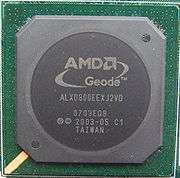
- LX 600@0.7 W: clock speed: 366 MHz, with power consumption: 1.2 watts. (TDPThermal Design PowerThe thermal design power , sometimes called thermal design point, refers to the maximum amount of power the cooling system in a computer is required to dissipate. For example, a laptop's CPU cooling system may be designed for a 20 watt TDP, which means that it can dissipate up to 20 watts of heat...
2.8 W) - LX 700@0.8 W: clock speed: 433 MHz, with power consumption: 1.3 watts. (TDPThermal Design PowerThe thermal design power , sometimes called thermal design point, refers to the maximum amount of power the cooling system in a computer is required to dissipate. For example, a laptop's CPU cooling system may be designed for a 20 watt TDP, which means that it can dissipate up to 20 watts of heat...
3.1 W) - LX 800@0.9 W: clock speed: 500 MHz, with power consumption: 1.8 watts. (TDPThermal Design PowerThe thermal design power , sometimes called thermal design point, refers to the maximum amount of power the cooling system in a computer is required to dissipate. For example, a laptop's CPU cooling system may be designed for a 20 watt TDP, which means that it can dissipate up to 20 watts of heat...
3.6 W) - LX 900@1.5 W: clock speed: 600 MHz, with power consumption: 2.6 watts. (TDPThermal Design PowerThe thermal design power , sometimes called thermal design point, refers to the maximum amount of power the cooling system in a computer is required to dissipate. For example, a laptop's CPU cooling system may be designed for a 20 watt TDP, which means that it can dissipate up to 20 watts of heat...
5.1 W)
Features:
- Low power.
- Full x86 compatibility.
- Processor functional blocks:
- CPU Core
- GeodeLink Control Processor
- GeodeLink Interface Units
- GeodeLink Memory Controller
- Graphics Processor
- Display Controller
- Video Processor
- Video Input Port
- GeodeLink PCI Bridge
- Security Block
- 128-Bit Advanced Encryption StandardAdvanced Encryption StandardAdvanced Encryption Standard is a specification for the encryption of electronic data. It has been adopted by the U.S. government and is now used worldwide. It supersedes DES...
(AES) - (CBC/ECB) - True Random Number Generator
- 128-Bit Advanced Encryption Standard
Specification:
- Processor frequency up to 600 MHz (LX900), 500 MHz (LX800) and 433 MHz (LX700).
- Power management: ACPI, lower power, wakeup on SMI/INTR.
- 64K Instruction / 64K Data L1 cache and 128K L2 cache
- Split Instruction/Data cache/TLBTranslation Lookaside BufferA translation lookaside buffer is a CPU cache that memory management hardware uses to improve virtual address translation speed. All current desktop and server processors use a TLB to map virtual and physical address spaces, and it is ubiquitous in any hardware which utilizes virtual memory.The...
. - DDR Memory 400 MHz (LX 800), 333 MHz (LX 700)
- Integrated FPU with MMX and 3DNow!3DNow!3DNow! is an extension to the x86 instruction set developed by Advanced Micro Devices . It adds single instruction multiple data instructions to the base x86 instruction set, enabling it to perform simple vector processing, which improves the performance of many graphic-intensive applications...
- 9 GB/s internal GeodeLink Interface Unit (GLIU)
- Simultaneous, high-res CRT and TFT (High and standard definition). VESA 1.1 and 2.0 VIP/VDA support
- Manufactured at a 0.13 micrometre process
- 481-terminal PBGA (Plastic Ball grid arrayBall grid arrayA ball grid array is a type of surface-mount packaging used for integrated circuits.- Description :The BGA is descended from the pin grid array , which is a package with one face covered with pins in a grid pattern. These pins conduct electrical signals from the integrated circuit to the printed...
) - GeodeLink active hardware power management
- Compatible with Socket 7Socket 7Socket 7 is a physical and electrical specification for an x86-style CPU socket on a personal computer motherboard. The socket supersedes the earlier Socket 5, and accepts P5 Pentium microprocessors manufactured by Intel, as well as compatibles made by Cyrix/IBM, AMD, IDT and others.Socket 7 was...
motherboards
Geode NX
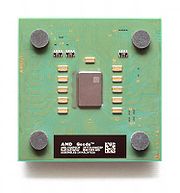
- NX 1250@6W: Clock speed: 667 MHz, average power consumption 6 watts, TDP 9 watts (1.0 volts core operating voltage).
- NX 1500@6W: Clock speed: 1 GHz, average power consumption 6 watts, TDP 9 watts (1.1 volts core operating voltage).
- NX 1750@14W: Clock speed: 1.4 GHz, average power consumption 14 watts, TDP 25 watts (1.25 volts core operating voltage).
Features:
- 7th generation core (based on Mobile Athlon XP-M).
- Power management: AMD PowerNow!, ACPI 1.0b and ACPI 2.0.
- 128 KB L1 cache.
- 256 KB L2 cache with hardware data prefetch
- 133 MHz Front Side Bus (FSB)
- 3DNow!, MMX and SSE instruction sets
- 0.13 µm (130 nm) fabrication process
- Pin compatibility between all NX family processors.
- OS support: Linux, Windows CE, MS Windows XP.
- Compatible with Socket ASocket ASocket A is the CPU socket used for AMD processors ranging from the Athlon Thunderbird to the Athlon XP/MP 3200+, and AMD budget processors including the Duron and Sempron. Socket A also supports AMD Geode NX embedded processors...
motherboards
Geode NX 2001
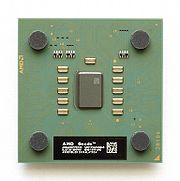
Socket A
Socket A is the CPU socket used for AMD processors ranging from the Athlon Thunderbird to the Athlon XP/MP 3200+, and AMD budget processors including the Duron and Sempron. Socket A also supports AMD Geode NX embedded processors...
).
Chipsets for Geode
- NSC Geode CS5530A Southbridge for Geode GX1.
- NSC/AMD Geode CS5535 Southbridge for Geode GX(2) and Geode LX (USB 1.1). Integrates four USB ports, one ATA-66 UDMA controller, one Infrared communication port, one AC'97 controller, one SMBUSSystem Management BusThe System Management Bus is a single-ended simple two-wire bus for the purpose of lightweight communication...
controller, one LPCLow Pin CountThe Low Pin Count bus, or LPC bus, is used on IBM-compatible personal computers to connect low-bandwidth devices to the CPU, such as the boot ROM and the "legacy" I/O devices . The "legacy" I/O devices usually include serial and parallel ports, PS/2 keyboard, PS/2 mouse, floppy disk controller...
port, as well as GPIO, Power Management, and legacy functional blocks. - AMD Geode CS5536 Southbridge for Geode GX and Geode LX (USB 2.0). Power consumption: 1.9 W (433 MHz) and 2.4 W (500 MHz). This chipset is also used on PowerPC board (Amy'05).
- Geode NX processors are "100 percent socket and chipset compatible" with AMD's Socket ASocket ASocket A is the CPU socket used for AMD processors ranging from the Athlon Thunderbird to the Athlon XP/MP 3200+, and AMD budget processors including the Duron and Sempron. Socket A also supports AMD Geode NX embedded processors...
Athlon XP processors: SIS741CX Northbridge and SIS 964 Southbridge, VIA KM400 Northbridge and VIA VT8235 Southbridge, VIA KM400A Northbridge and VIA VT8237R Southbridge and other Socket A chipsets.
See also
- ALIXAlixAlix, or The Adventures of Alix, is a popular Franco-Belgian comics series drawn in the ligne claire style by one its masters, Jacques Martin. The stories revolve around a young Gallo-Roman man named Alix in the late Roman Republic...
- Cyrix Cx5x86Cyrix Cx5x86Released in August 1995, four months before the more famous Cyrix 6x86, the Cyrix 5x86 was one of the fastest CPUs ever produced for Socket 3 computer systems...
- WRAPWireless Router Application PlatformThe Wireless Router Application Platform is a format of single board computer defined by Swiss company PC Engines. This is specially designed for wireless router, firewall, load balancer, VPN or other network appliances.-Basic specs:...
- 3Com Audrey3Com AudreyThe 3Com Ergo Audrey is a discontinued internet appliance from 3Com. It was released to the public on October 17, 2000 for USD499 as the first device in the company's "Ergo" initiative to hit the market...
- KooluKooluKoolu was a Canadian company started by Andrew Greig and Jon "maddog" Hall, which aim is to provide low-power computer appliances powered by free- and open-source software. It is now defunct....
- LinutopLinutopThe Linutop is a small, light, environment friendly nettop computer with a metal case, no moving parts, and running the Linutop OS , a customized version of Linux based on the Xubuntu then Ubuntu/GNOME distribution....
- NetbookNetbookNetbooks are a category of small, lightweight, legacy-free, and inexpensive laptop computers.At their inception in late 2007 as smaller notebooks optimized for low weight and low cost — netbooks omitted certain features , featured smaller screens and keyboards, and offered reduced computing...
- MediaGXMediaGXThe MediaGX CPU was an x86 processor manufactured and designed by Cyrix and later after merger manufactured by National Semiconductor, and was introduced in 1997. The core is based on the integration of the Cyrix Cx5x86 CPU core with hardware to process video and audio output...
- Soekris
- Sony eVillaSony eVillaThe Sony eVilla is a discontinued Internet appliance from Sony. After 18 months of development, it was released to the public on June 14, 2001 for $499 USD...
- ThinCanThinCanThinCan is the name for a thin client manufactured by Estonian electronic design start-up Artec Group. The ThinCan remained relatively unknown outside Estonia until 2006, when a recent ThinCan iteration was selected as the hardware base for the Linutop, a network appliance that greatly stimulated...
- Virgin WebplayerVirgin WebplayerThe Virgin Webplayer is a discontinued Internet appliance from Virgin Group. The device was intended as a standalone Internet access device, running a specialized operating system which limited it to the Virgin Connect ISP. It was discontinued on November 15, 2000. The remaining Webplayer...
- PC/104PC/104PC/104 is an embedded computer standard controlled by the which defines both a form factor and computer bus. PC/104 is intended for specialized embedded computing environments where applications depend on reliable data acquisition despite an often extreme environment...
- Intel AtomIntel AtomIntel Atom is the brand name for a line of ultra-low-voltage x86 and x86-64 CPUs from Intel, designed in 45 nm CMOS and used mainly in netbooks, nettops, embedded application ranging from health care to advanced robotics and Mobile Internet devices...
- VIA NanoVIA NanoThe VIA Nano is a 64-bit CPU for personal computers. The VIA Nano was released by VIA Technologies in 2008 after five years of development by its CPU division, Centaur Technology...
External links
- AMD pages for Geode
- AMD Geode LX800 product information
- AMD Geode LX Processors Data Book
- National Semiconductor press release: Cyrix -> VIA, MediaGX -> Geode
- National Semiconductor press release: Geode sold to AMD
- CPU-INFO: Cyrix MediaGX, indepth processor history
- Voltage and P State information for Geode NX
- Quixant QX-10 Geode NX Motherboard for gaming applications
- Soekris Engineering sells embedded boards with Geode processors
- PC Engines ALIX another embedded board with Geode LX processor
- CM-iGLX the smallest Computer On Module based on Geode LX
- Fit-PC full-featured end-user product based on the CM-iGLX PC-on-module above
- Artec Group manufactures products based on the Geode such as the ThinCanThinCanThinCan is the name for a thin client manufactured by Estonian electronic design start-up Artec Group. The ThinCan remained relatively unknown outside Estonia until 2006, when a recent ThinCan iteration was selected as the hardware base for the Linutop, a network appliance that greatly stimulated...
. - Troika NG PowerPC board using CS5536.
- Technexion manufactures a Geode LX based motherboard (TIM-3900-LX)
Linux on Geode
- Installing Linux on Geode-based Single-Board Computers
- DEvoSL - DSL on Evo T20 HowTo
- Compaq Evo T20 Notes
- Installing Linux onto the IBM Netvista N2200
- Linux on CASIO Cassiopeia Fiva
- Linux with Cyrix MediaGXm, NSC/AMD Geode GX
- Linux Development on the Pepper Pad 3
- Patching linux with OCF to hook into Geode's AES Security Block
- Pus-pus is a compact Debian-based distribution to run onto the IBM Netvista N2200
- Zeroshell router/firewall appliance
NetBSD on Geode
- Wasabi Systems Certified NetBSD port and NAS software

